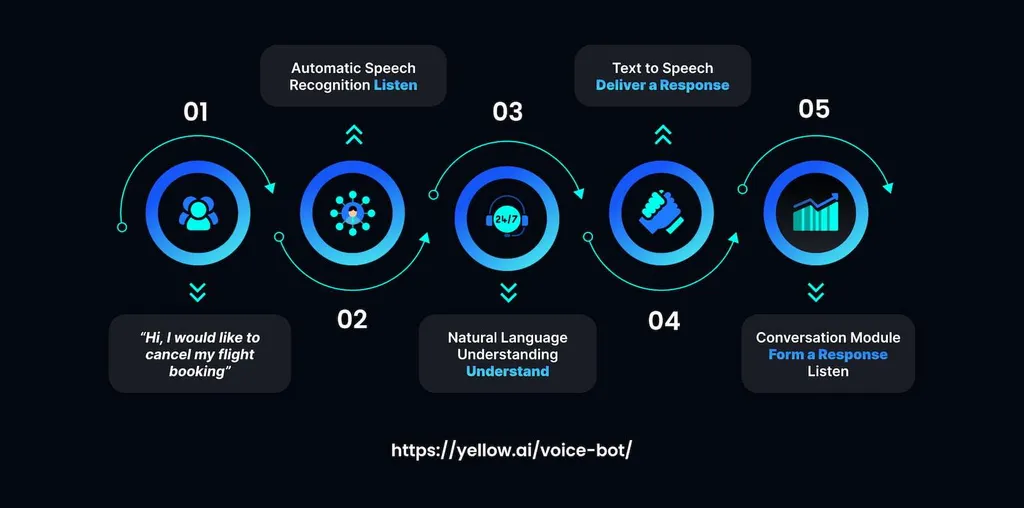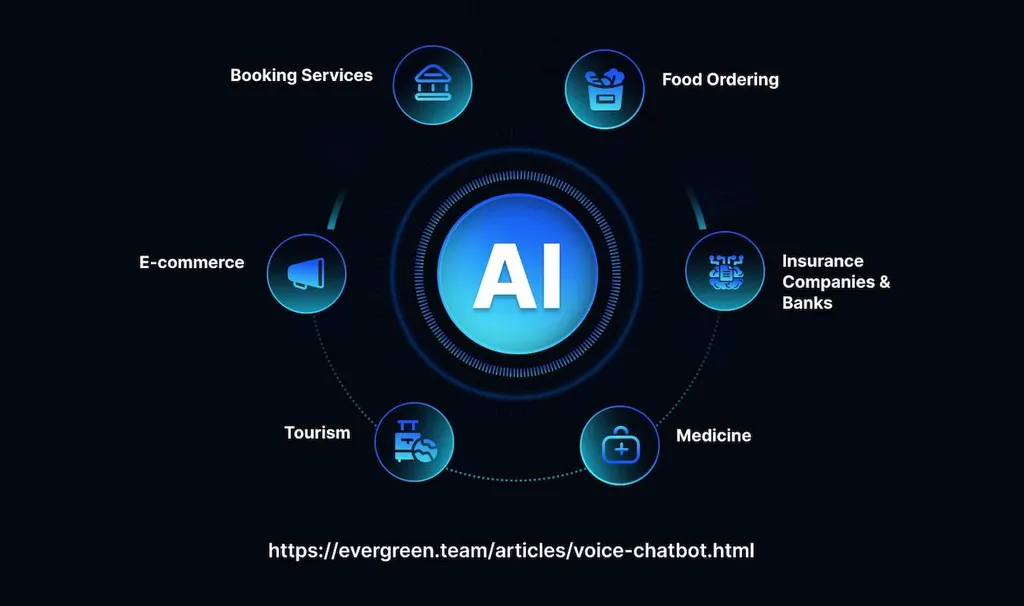Customer expectations have evolved dramatically with the progress of IoT and the overall digital landscape, and firms that fail to keep up risk losing their clients. However, following trends and staying on top requires significant investments and human resources. But, due to the adoption of AI technology with a variety of tools, SLMs, and LLMs, you can stay afloat without expanding your staff. In this guide, we will explain the details of AI voice chatbots’ functioning and how they interact with clients, boost sales, and improve retention.
The Mechanics Behind AI Voice Chatbots
By combining machine intelligence with speech recognition, voice-based chatbots provide interactive and human-like support. Unlike traditional chatbots that are designed to handle text-based interactions, these tools mimic human speech to deliver a more intuitive and seamless experience.
At their core, voice bots operate through the following stages:
- Transcription: The system converts spoken words into text to grasp the request.
- Linguistic data processing: Then, it analyzes the intent behind the words to give relevant and human-like answers to the question.
- Context awareness: Advanced AI bots use context from past interactions, ensuring continuity in conversations.
- Adaptation and education: Such systems can self-educate and develop over time. It learns from user sessions to refine responses and boost accuracy.

From the client’s side, the process is very simple. The individual starts speaking to the voice-based bot. It figures out what the user wants and responds in a way that’s easy to understand. The issue is solved without escalating requests to human agents.
Popular Types of Voice Chatbots
There are several types of voice bots and AI agents, each designed for different purposes. Let’s explore the most common categories:
- Scripted voice bots: These tools operate on predefined rules, responding to users based on structured scripts and set pathways.
- Adaptive AI voice bots: Capable of learning and refining their responses over time, these bots improve interactions by recognizing new patterns in conversations.
- Conversational AI bots: Developed to engage in dynamic, natural language discussions, these helpers create human-like interactions.
- Personal voice bots: These assistants execute specific commands and predefined functions, helping users complete routine tasks efficiently.
- Voice-activated assistants: Leveraging natural language processing, these AI-powered assistants offer flexible support, handling diverse user requests with minimal constraints.
Define all your goals to select the most appropriate type to fulfill your needs.
How AI Voice Chatbots Elevate the Customer Experience
Customer experience is a critical differentiator in today’s competitive environment. Let’s explore how voice AI customer service solutions improve interactions and how they are important for firms in the table below.
| Feature | Explanation | Grade of Importance for Business (1-10) |
| 24/7 availability | In contrast to human agents, AI bots work around the clock, guaranteeing customers receive instant responses when needed. | 10 |
| Faster response times | Voice-managed tools process requests in seconds, eliminating frustrating wait times and growing customer satisfaction. | 10 |
| Personalized interactions | AI can analyze customer preferences and past behaviors to offer tailored advice and solutions. | 8 |
| Multilingual support | Many businesses today operate globally, and AI voice bots can speak in many languages, breaking down language barriers. | 8 |
| Cost efficiency | Such tools reduce the need for large customer support teams and minimize operational expenditures. | 10 |
| Emotion recognition | They detect customer sentiment and adjust responses accordingly. | 7 |
A voice-managed chatbot is essential in areas where the time of response and quality of interaction with clients are critical. You can use it in call centers, healthcare, traveling and hospitality, retail, finances, and other areas.

Take the tourism industry as an example. Hotels increasingly integrate Interactive Virtual Response (IVR) systems to enhance guest experiences. IVR technology allows ordering room service, adjusting room settings (like temperature or lighting in smart hotels), and receiving local recommendations without speaking to a human operator. This not only boosts convenience but also improves customer engagement.
Growing Sales and Conversion with Voice-Managed Assistants
Beyond customer service, AI voice chatbots play a significant role in increasing sales and conversions. Here’s how:
- Seamless purchasing: AI chatbots enable voice-activated shopping, allowing buyers to place orders effortlessly. For instance, Domino’s Pizza allows customers to order via Alexa to simplify the buying process.
- Upselling and cross-selling: AI can suggest complementary products or upgrades based on user preferences. An AI assistant for an online clothing store might recommend matching accessories when a customer purchases a dress.
- Guided assistance: Voice bots can answer product-related questions in real time, addressing hesitations and raising the likelihood of purchase.
For better performance, you should pay attention to fine-tuning your AI voice chatbot based on customer interactions and feedback. Regularly update the system to ensure it can respond accurately to inquiries. Analyzing data from past interactions can help spot areas where the chatbot might struggle, allowing for adjustments in its responses. Additionally, training the AI on different accents, tones, and speech patterns will make it more adaptable to diverse customers. Testing different conversation flows will help the chatbot better understand and respond to varied queries, ultimately enhancing the customer experience.
How AI Voice Chatbots Improve Customer Retention
Client loyalty is as important as attracting new customers, and AI voice bots contribute significantly to building long-term relationships:
- Proactive engagement: AI bots can write to customers with advice, reminders, and individualized offers, fostering loyalty.
- Efficient problem resolution: Quick and accurate assistance leads to higher customer satisfaction, reducing churn rates.
- Feedback collection: Firms can use AI to gather and analyze customer feedback to identify potential improvement areas.
For instance, banks are deploying chatbot vocal technology to remind customers about upcoming bill payments, reduce late fees, and improve financial management. These proactive engagements increase trust and keep customers engaged with the brand.
Final Words
Companies that once struggled with long wait times and incorrect responses now have the ability to provide lightning-speed, intelligent, and even emotionally aware interactions regardless of working hours. As AI technology advances, chatbots are moving beyond scripted replies. They learn to handle complex troubleshooting, detect interlocutor sentiments, and adapt their tone accordingly.
Speaking about the future of AI voice chatbots, we expect a heightened level of personalization and deeper integration with business systems. AI tools will more accurately anticipate customer needs and offer proactive solutions. As multimodal AI evolves, chatbots will effectively combine voice, text, and visual elements to create more intuitive customer experiences.
With MetaDialog’s solutions, you can deliver 24/7 support that feels natural. By automating routine inquiries, reducing pressure on human agents, and ensuring high-quality service, it is easy to scale while keeping customers engaged and happy.
